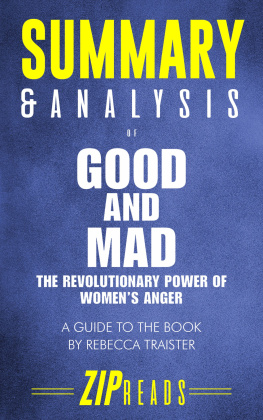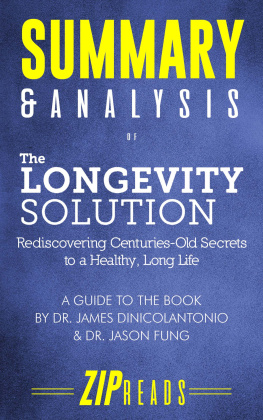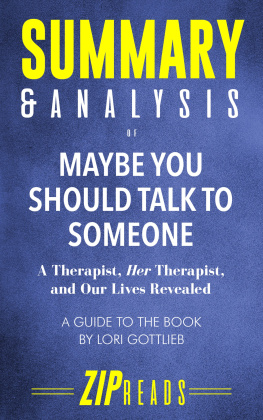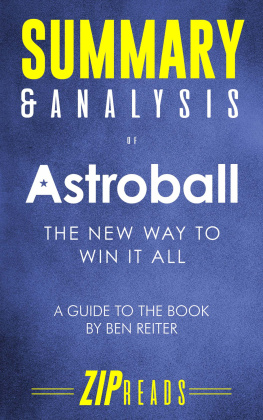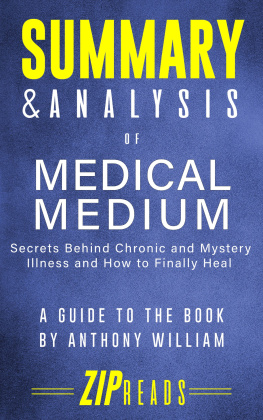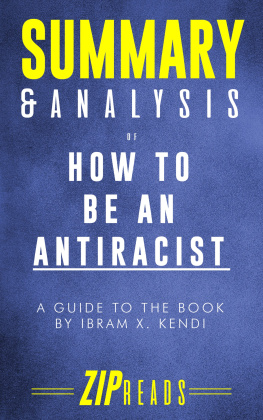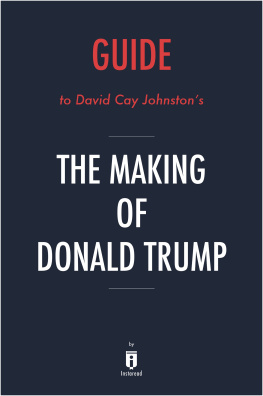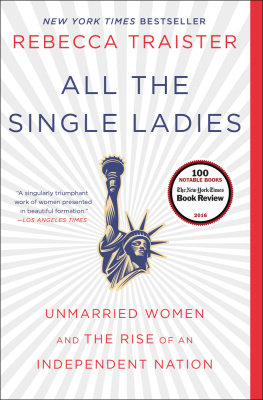
NOTE: This book is a summary and analysis and is meant as a companion to, not a replacement for, the original book.
Please follow this link to purchase a copy of the original book: https://amzn.to/2pPeKVH
Copyright 2018 by ZIP Reads. All rights reserved. This book or parts thereof may not be reproduced in any form, stored in any retrieval system, or transmitted in any form by any meanselectronic, mechanical, photocopy, recording, or otherwisewithout prior written permission of the publisher, except as provided by United States of America copyright law. This book is intended as a companion to, not a replacement for the original book. ZIP Reads is wholly responsible for this content and is not associated with the original author in any way.
TABLE OF CONTENTS
SYNOPSIS
Good and Mad: The Revolutionary Power of Womens Anger is the story of womens anger both from an emotional and historical perspective. Author Rebecca Traister argues that many of the great movements in history have been sparked by angry women, yet the history we are taught in school tends to overlook this fact. Traister begins the book with a look back to the feminist movement of the 1960s and 70s and the unbridled anger that accompanied it. Women had had enough and were no longer going to demurely accept the inequality and harassment that had plagued the female gender for so long. With the power of this movement came a lot of social change including increased protections in the workplace and increased sexual and professional freedom. Until its crashing dnouement, that is, when the Equal Rights Amendment was defeated in 1982ironically by a womanantifeminist hero Phyllis Schlafly.
While recounting stories of the many angry women who helped drive this progress and other revolutions throughout history, Traister is quick to recognize her own softening of anger to be more palatable and amenable to a male-dominated culture. The book works its way through the suppression of feminism in the 80s and 90s, back to its early, yet quiet resurgence in the beginning of the past decade, and finally through the election of Donald Trump and the #metoo movement when women finally, once again, started to get mad.
Traister covers everything from the history of the womens suffrage movement to the long-standing cultural structures and mores that deem womens anger inappropriate. She discusses in detail the forces through which women support the patriarchy that oppresses them and spends much of the book on the details of specific women who either helped or hurt the movement, and how. From Gloria Steinem and Flo Kennedy of the Second Wave of feminism; to the first black congresswomen and senators; to the complicated dynamics of race, activism, the #metoo movement, and its continued repercussions Traister leaves no stone unturned in her exploration of female anger, oppression, and progress.
Part I: ERUPTION
Key Takeaway: The feminism of the past three decades was a toned-down version of the anger of the 1970s.
After the womens movement of the 1960s and 70s shifted into the 80s and 90s, the word feminist itself became an insulta reference to lonely, bitter, man-hating bitches. Self-proclaimed feminists distanced themselves from the word for fear of working against their own cause: nobody likes an angry feminazi. Successful, single women in the movies were painted as lonely, mean workaholics or sex-starved psychopaths. In the religious moral majority of the Reagan era, rights just gained for the disadvantagedlike welfare, food stamps, and reproductive autonomywere quickly under attack.
In response, the answer was for women to tone down their feminism; tone down their anger. Women no longer screamed about injustice but kindly suggested it. Feminist rhetoric in the past two decades (like that of the authors) became relatable and agreeable because it had to in order for anyone to listen to it. Even Barack Obama was a famously un-angry black man, aware that any outburst would jeopardize his place in the system.
What arose was a feminism that was cool, not too hard to swallow. With sex positivity, an all-female Ghostbusters, and Beyonc proclaiming herself a #FEMINIST at the MTV Video Music Awards in 2014, feminism was mainstream, and it was hipbut no one was getting angry.
Those few women who gained power within the white male patriarchylike Hillary Clinton and Beyoncdid so with the agreement they wouldnt be angry, and they wouldnt try to tear it down. Infuriated women screaming and threatening to burn it to the ground were too dangerous in 2016 with the first real possibility of a female president. Successful women would risk being cast as angry outsiders if they dared address the topic of feminism or inequality with anger rather than calm appeal. To succeed in the system, you had to play by its rules.
Key Takeaway: The myth that inequalities had been overcome stoked the ire of the white male patriarchy.
Those few women who rose to power were charged with perpetuating the myth that equality had mostly been reached and nothing was wrong. The line went: both racism and sexism are things of the past, as you can see by the very small and unrepresentative number of minorities serving in government.
Unfortunately, what this myth created was a backlash against the myth by those who felt power and privilege were a zero-sum gameif a black woman gets some, then a white man must be losing some. Donald Trumps presidential campaign in a country that had told itself it was beyond such racism and misogyny proved exactly how untrue that was.
The vitriol against both Barack Obama and Hillary Clinton was highlighted with chants to Hang the Bitch or Fuck that n , and it wasnt relegated just to the fringe of Trumps supporters.
Because Hillary had played the patriarchys game of supporting Wall Street, as well as welfare and immigration reform in the 90spolicies which hurt the poor and helped the eliteshe became a target for the anti-establishment rhetoric that drove Trump to victory. This image as a disconnected elite hurt her in her own party as well, as progressives rallied behind Bernie Sanders. The author notes that while the misogyny on the right was clear cut, on the left it was somewhat more ambiguous, though still clearly at play. Even in the Occupy Wall Street movement and the rhetoric about Clinton from opponents in her own party could rampant sexism be seen.
Key Takeaway: The anger of women at Donald Trump was quieted by the false belief in a post-misogynist society.
When the infamous Access Hollywood tape came out where Donald Trump boasted about grabbing women by the pussy, women, and men, around the country were rightfully furious. With all the hatred and bigotry spewing from Trump, everyone expected Hillary to win. In a post-misogynist society, a cartoonish villain like Trump could never be elected. But what no one expected was that that this kind of talk is exactly what energized his base. His dismissive views on women represented everything that the country used to feel about womens place in society relative to men: Make America Great Again meant Make Women Submissive Again. While powerful women like Michelle Obama and Beyonc were finally getting angryalong with many average, unpowerful womenthe narrative remained that Hillary Clinton would win. This narrative was so strong, the author argues, that it encouraged women to inaction. Nothing needed to be done in order to stop Trump, Clinton was a shoe-in.
In treating her as though she had already beat him, and not like the single tool on the table with which the nation might stop this monstrous racist patriarch, we talked ourselves out of the outrage we should have been mustering.
Next page
